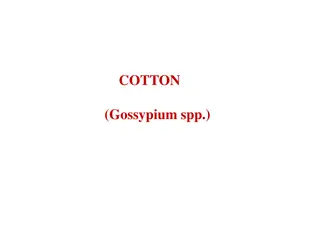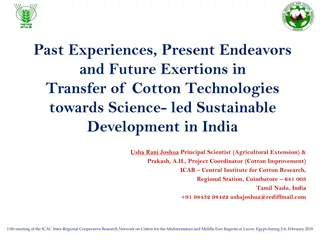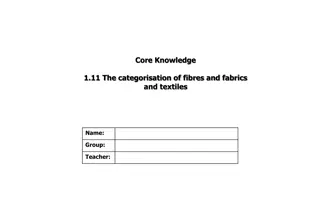Understanding Mercerization Process in Cotton Textiles
Mercerization is a key process in textile manufacturing where cotton is treated with caustic soda solution to enhance properties such as fiber strength and luster. This treatment involves specific conditions like temperature, dwell time, and tension control to prevent shrinkage. By understanding the process and conditions of mercerization, textile producers can improve the quality of their cotton products.
Download Presentation

Please find below an Image/Link to download the presentation.
The content on the website is provided AS IS for your information and personal use only. It may not be sold, licensed, or shared on other websites without obtaining consent from the author. Download presentation by click this link. If you encounter any issues during the download, it is possible that the publisher has removed the file from their server.
E N D
Presentation Transcript
Mercerization Mercerization is a process in which cotton is treated with a caustic (NaOH) solution to improve properties such as fiberstrength, shrinkage resistance, luster, and dye affinity. The caustic actually rearranges the cellulose molecules in the fiber to produce thesechanges
Mercerization Mercerization is defined as the treatment of cotton textiles with a concentrated solution of alkali consisting the following conditions: Application of caustic soda solution 31 to 35% at a temperature of 15 to 18C. A dwell period of 1 minute on an average, so as to permit diffusion of alkali into the fibre. Warp tension during alkali treatment and stretching the weft (width) of the fabricduring washing are necessary to prevent shrinkage. Finally, washing-off of the traces of alkali from the treated fibres.
Conditions of Mercerization Mercerization may be carried out on grey fibres or afterscouring/bleaching. If mercerization is carried out in the grey state, complete removal of alkali is not necessary during washing treatmentas the residual alkali in the cloth is used for the kier process.
Conditions of Mercerization However, mercerization is commonly carried out after scouring, but it is preferable to mercerize after bleaching if continuous bleaching plant is available. Another mercerization is the rapid and uniform wetability of the grey cloth. necessary condition for successful
Conditions of Mercerization Penetration of alkali is hindered by: the high viscosity of the strong caustic soda solution at lower temperature The hydrophobic nature of the fatty matter present in the size coating as well as natural fats and waxes present in the fibre on theother. To obviate these problems a small amount of penetrating and wetting agent is added to thecaustic bath. In case of mercerization of knit goods which contain paraffin products, the wetting agents used must also possess dispersing power towards these products.
Mercerization The Process The fabric is first immersed in a caustic solution of about 23% strength and a relatively cool temperature of 16-32 C It is then fed around a series of rollers (timing cans) which keep it flat and smooth while controlling the time of causticexposure (dwell time: 45 sec to 5 min) The fabric is then sprayed with rinse water and then washed with a neutralizing chemical before final drying
Process Parameters Caustic strength Swelling increases with strength Dwell time (feed rate) Tension Improves lustre and tensile strength temperature Cellulose swelling increases with a drop of temperature Neutralization
Neutralization High concentration of caustic in fabric must have to be removed For optimum dyeing For better fastness properties Done with Intensive washing Acetic acid treatment
Effect of Mercerization on Cotton Molecular Level Hydrogen bond readjustment Orientation (parallelization) of molecular chains in amorphous region along the direction of fiber length Orientation of the crystallinity in the direction of the fiber length Increased crystallinity Swelling Chemical Changes Increase in Luster
Effect of Mercerization on Cotton Fiber level Swelling Swell nearly 150% and almost 9% contraction in length. The cross section of cotton fibre is increased by 40 to 50% Will cause shrinkage so the fabric must be stretched before removing the caustic solution The size of pores in the fibrous ,material is considerably increased Bean shape is converted to round shape Immature fibers The fiber untwists Increased tensile strength (due to removal of weak spots on untwisting)
Effect of Mercerization on Cotton Chemical Changes Formation of soda cellulose Increase in absorbency Increased reactivity Liberation of heat during the caustic treatment.(heat of sorption and heat of reaction) Increase in the alkali absorption
Mechanism of Mercerization It is assumed that cellulose combines with caustic soda to form alkali-cellulose and swelling is due to the molecularattractionwith associated hydration. C6H9O4 -OH + NaOH = C6H9O4 -ONa + H2O Cellulose + Caustic = Soda Celulose + Water The extent of this combination is governed by the concentrationof alkali.
Mechanism of Mercerization Maximum concentration is the result of: theattraction of alkali-celluloseon the one hand and the remaining freealkali on the other. swelling in particular range of alkali The hydration of the cellulose increases with the increased fixation of alkali in solutions of rising concentrations up to a certain limit, after which free alkali exerts a dehydrating effect on the alkali-cellulose to a great extent.
Increase in Lusture Unmercerized cotton has a general appearance of a flat ribbon with spiral twists, its surface is rough and non-uniform, its cross-section is irregularand ear-shaped . All these factors result in less lustre. When a cotton fiber is brought into an aqueous solution of sodium hydroxide cellulose begins to swell immediately, the fiber is elliptical in section in a few seconds, and on further swelling becomes circular.
Increase in Lusture The untwisting of the fibre takes place under effect of swelling and increased alignment. When cotton is mercerized without tension, the fibre while much smoother and rounder with little or no twist, still show residual creases and wrinkles and there is no appreciable increase in lustreas the cross-section is oval. Lustre increases as the tension applied to the fibre during mercerization is increased. It also depends on concentration, and increases from 180 g/l of NaOH solution to a maximum at 260-300 g/l, then decreases slightly
Gain in strength Mercerization, both slack and with tension, increases the strength uniformityalong the fibre length. Mercerization increases the tensile strength of cotton fibres byeliminating the weakest points in the fibre. Mercerization individual cotton fibers and this closer embedding not only increases the strength but makes it more uniform in strength. increases the cohesion between
Gain in strength The physical properties of mercerized fibres are related to the orientation factor; the Young's modulus increases with increase in orientation. The increase in orientation of the crystallites with respect to fibre axis can be attributed to fibredeconvolution. In case of slack mercerized cotton increased strength is accompanied by an increase in extensibility, thus deconvolution is not the only factor influencing thechanges in mechanical properties. The twist of yarn plays an important role and low twist appears to be essential for maximum increase in strength.
Increased moisture absorption Mercerized celluloses absorb more water, have higher regains and more easily wet out than unmercerized fibres. Due to caustic soda penetration, many hydrogen bonds are broken and it is estimated that the number of available, hydroxyl groups are increased by about 25%. Mercerization, thus decreases the amount of crystalline part or increases the amorphouscontent of the fibre. When mercerization is carried out under tension, the changes in crystalline portion is comparatively lower than that without tension and hence also the moisture sorption. Standard cotton has moisture content of about 7%, mercerized cotton with tension has about 9% and thatof without tension about 11%.
Increased dye adsorption Mercerized cotton shows increased depth of shade, rateof dyeing and While decrease the irregularities due to neps and unripe cotton. The increased depth of shade of mercerized cotton has been attributed due to increased amorphous part of the fibre.
Removal of immature cotton Mercerization has been recognised as a method for removing immature (dead) fibres to obtain level dyeing effecton cotton fabrics. The dead fibres are under developement and appear as flat or slightly twisted tapes. They are non-crystalline, convolutions are sometimes absent, cell walls are extremely thin and the lumen is collapsed and hence do not contain dye to same extent as matured fibres.
Physical compactness Mercerization improves dimensional stability of cotton woven fabrics . When knitted fabrics are compared with respect to their relative openness, temperature increase can be said to improve mercerization because when the goods are bleached and then mercerized, the fabric becomes moredense. However, when unbleached fabrics are mercerized, the fabrics become moreopen. Mercerization also gives moderate improvement in crease recovery of cotton fabrics as well as some protection against the decrease in tensilestrengthcaused by easy-care finishing.
Causticization Cotton can be causticized or half-mercerized to increase the dye uptake. Semi-mercerization or causticization is carried out in caustic soda solution between 25 and 30 Tw(Twaddle) at a temperature of 20- 25 C sometimes without stretching the cloth to restore original dimensions. Sodium hydroxide solution above 30 Tw decreases the rate of colourabsorption. Semi mercerization is also an important step where heavy shades are required with the expensivevat colours.
1.Classification according to the form of the product a) Yarn mercerization Batch : Hank mercerization Cheese mercerization Continuous : Single end mercerization Tow mercerization Warp mercerization
1.Classification according to the form of the product b)Knit Mercerization Open mercerization Closed mercerization (Round mercerization, tubular knit mercerization) c) Cloth mercerization Chainless mercerization (Roller mercerization) Chain mercerization (Stenter mercerization) Batch-up mercerization
2.Classification according to the mercerizing conditions a) Water content Dry mercerization Wet mercerization b) Tension Fixed-length mercerization Tension mercerization Tensionless mercerization
3.Classification according to timing Gray mercerization Pre-dyeing mercerization Post-dyeing mercerization
4. Classification according to the number of treatments Single mercerization Double mercerization 5. Classification according to the type of alkali used Caustic soda mercerization Ammonia mercerization 6. Other Alkali pad-dry method Alkali pad-steam method
c)Alkaline concentration Low-concentration alkaline mercerization High-concentration alkaline mercerization Two-step mercerization d) Temperature Ambient-temperature mercerization High-temperature mercerization Low-temperature mercerization
Machines Used Have four basic sections Mercerizing section; impregnator Squeezing section Stabilizing section (dwell time and concentration reduction) Squeezing section Washing and neutralization Machine types Chain Machines Chainless machines
Chainless mercerization This method of mercerization running fabric through a number of rollers without the use of a clip stenter is also called roller mercerization. The machine used has a number of stainless rollers, or stainless and rubber rollers, of a relatively-large diameter tiered zigzag in close contact to each other inside a long trough, with the lower tier designed to submerge in alkaline solution for mercerization. The absorption of alkaline solution and fabric swelling take place as fabric sequentially glides through the surface of these rollers, and, although this movement from roller to roller in close contact with them reduces the widthwise contraction to a minimum, the resulting fabric expansion remains within a limited range, thus displaying the mechanism of mercerization at fixed length. .
Chain mercerization In order to make up for the shortcomings of the roller mercerizing machine, a clip stenter is used for post-mercerization treatment, in which a widthwise tension is applied then most alkali is showered off the fabric kept on the stenter, followed by thorough alkali removal and neutralization using an open-width washing machine. As for practical machinery, a heavy padding mangle is used for the application of alkaline solution in the 2 dip/2 nip method, with sufficient time allowed for penetration and swelling of the fabric in a timing cylinder, instead of undergoing an operation using so many rollers and so much solution as in roller mercerization, to ensure reduced use of the alkali.
Cold mercerization The mercerization process take place at the 15 to 18 C with 31 to 35% caustic soda solution, with a dewlling period of 50 sec. At this stage cotton swell best but also fastest. The fast swelling increased the outer edge density of fibers. The viscosity of caustic soda such that the penetration into gray fabric become difficult, which result the poor mercerization of core and the lack of uniformity as the reaction is restricted to the surface of the yarn or fabric.
Hot mercerization The mercerization process take place at higher temperature with 30 to 38 Be caustic soda solution, with a dwelling period of 20 to 30 sec. Advantages of hot mercerization Rapid penetration of alkali Improve core mercerization More uniform treatment Low dwell time
Disadvantage Less luster High energy consumption
Evaluation Degree of deconvolation Observed undera microscope Swelling index Measured by observing untwisting in yarn under strong alkali solution Staining test cotton is unmercerized cotton remains white with iodine solution Mercerized stained bluish black and
References Chemical technology in the pre-treatment processes of textiles by S.R. Kar Makar























